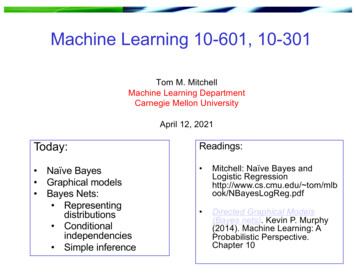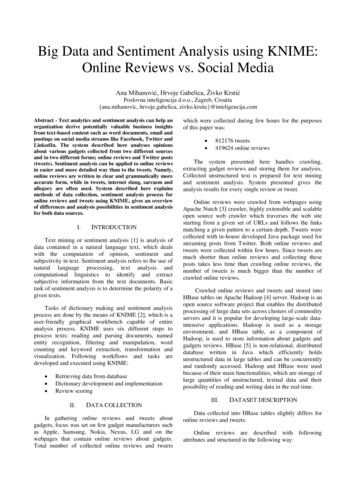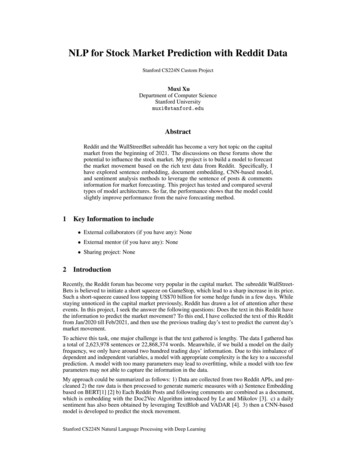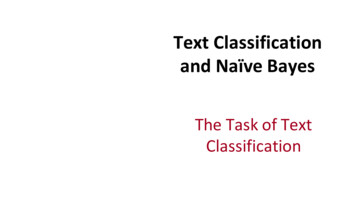
Transcription
Speech and Language Processing. Daniel Jurafsky & James H. Martin.rights reserved. Draft of September 21, 2021.Copyright 2021.AllCHAPTER4Naive Bayes and SentimentClassificationClassification lies at the heart of both human and machine intelligence. Decidingwhat letter, word, or image has been presented to our senses, recognizing facesor voices, sorting mail, assigning grades to homeworks; these are all examples ofassigning a category to an input. The potential challenges of this task are highlightedby the fabulist Jorge Luis Borges 1964, who imagined classifying animals into:(a) those that belong to the Emperor, (b) embalmed ones, (c) those thatare trained, (d) suckling pigs, (e) mermaids, (f) fabulous ones, (g) straydogs, (h) those that are included in this classification, (i) those thattremble as if they were mad, (j) innumerable ones, (k) those drawn witha very fine camel’s hair brush, (l) others, (m) those that have just brokena flower vase, (n) those that resemble flies from a distance.textcategorizationsentimentanalysisMany language processing tasks involve classification, although luckily our classesare much easier to define than those of Borges. In this chapter we introduce the naiveBayes algorithm and apply it to text categorization, the task of assigning a label orcategory to an entire text or document.We focus on one common text categorization task, sentiment analysis, the extraction of sentiment, the positive or negative orientation that a writer expressestoward some object. A review of a movie, book, or product on the web expresses theauthor’s sentiment toward the product, while an editorial or political text expressessentiment toward a candidate or political action. Extracting consumer or public sentiment is thus relevant for fields from marketing to politics.The simplest version of sentiment analysis is a binary classification task, andthe words of the review provide excellent cues. Consider, for example, the following phrases extracted from positive and negative reviews of movies and restaurants.Words like great, richly, awesome, and pathetic, and awful and ridiculously are veryinformative cues: spam detectionlanguage idauthorshipattribution.zany characters and richly applied satire, and some great plot twistsIt was pathetic. The worst part about it was the boxing scenes.awesome caramel sauce and sweet toasty almonds. I love this place!.awful pizza and ridiculously overpriced.Spam detection is another important commercial application, the binary classification task of assigning an email to one of the two classes spam or not-spam.Many lexical and other features can be used to perform this classification. For example you might quite reasonably be suspicious of an email containing phrases like“online pharmaceutical” or “WITHOUT ANY COST” or “Dear Winner”.Another thing we might want to know about a text is the language it’s writtenin. Texts on social media, for example, can be in any number of languages andwe’ll need to apply different processing. The task of language id is thus the firststep in most language processing pipelines. Related text classification tasks like authorship attribution— determining a text’s author— are also relevant to the digitalhumanities, social sciences, and forensic linguistics.
2C HAPTER 4supervisedmachinelearning4.1 NAIVE BAYES AND S ENTIMENT C LASSIFICATIONFinally, one of the oldest tasks in text classification is assigning a library subject category or topic label to a text. Deciding whether a research paper concernsepidemiology or instead, perhaps, embryology, is an important component of information retrieval. Various sets of subject categories exist, such as the MeSH (MedicalSubject Headings) thesaurus. In fact, as we will see, subject category classificationis the task for which the naive Bayes algorithm was invented in 1961.Classification is essential for tasks below the level of the document as well.We’ve already seen period disambiguation (deciding if a period is the end of a sentence or part of a word), and word tokenization (deciding if a character should bea word boundary). Even language modeling can be viewed as classification: eachword can be thought of as a class, and so predicting the next word is classifying thecontext-so-far into a class for each next word. A part-of-speech tagger (Chapter 8)classifies each occurrence of a word in a sentence as, e.g., a noun or a verb.The goal of classification is to take a single observation, extract some usefulfeatures, and thereby classify the observation into one of a set of discrete classes.One method for classifying text is to use handwritten rules. There are many areas oflanguage processing where handwritten rule-based classifiers constitute a state-ofthe-art system, or at least part of it.Rules can be fragile, however, as situations or data change over time, and forsome tasks humans aren’t necessarily good at coming up with the rules. Most casesof classification in language processing are instead done via supervised machinelearning, and this will be the subject of the remainder of this chapter. In supervisedlearning, we have a data set of input observations, each associated with some correctoutput (a ‘supervision signal’). The goal of the algorithm is to learn how to mapfrom a new observation to a correct output.Formally, the task of supervised classification is to take an input x and a fixedset of output classes Y y1 , y2 , ., yM and return a predicted class y Y . For textclassification, we’ll sometimes talk about c (for “class”) instead of y as our outputvariable, and d (for “document”) instead of x as our input variable. In the supervisedsituation we have a training set of N documents that have each been hand-labeledwith a class: (d1 , c1 ), ., (dN , cN ). Our goal is to learn a classifier that is capable ofmapping from a new document d to its correct class c C. A probabilistic classifieradditionally will tell us the probability of the observation being in the class. Thisfull distribution over the classes can be useful information for downstream decisions;avoiding making discrete decisions early on can be useful when combining systems.Many kinds of machine learning algorithms are used to build classifiers. Thischapter introduces naive Bayes; the following one introduces logistic regression.These exemplify two ways of doing classification. Generative classifiers like naiveBayes build a model of how a class could generate some input data. Given an observation, they return the class most likely to have generated the observation. Discriminative classifiers like logistic regression instead learn what features from theinput are most useful to discriminate between the different possible classes. Whilediscriminative systems are often more accurate and hence more commonly used,generative classifiers still have a role.Naive Bayes Classifiersnaive BayesclassifierIn this section we introduce the multinomial naive Bayes classifier, so called because it is a Bayesian classifier that makes a simplifying (naive) assumption about
4.1bag-of-words NAIVE BAYES C LASSIFIERS3how the features interact.The intuition of the classifier is shown in Fig. 4.1. We represent a text documentas if it were a bag-of-words, that is, an unordered set of words with their positionignored, keeping only their frequency in the document. In the example in the figure,instead of representing the word order in all the phrases like “I love this movie” and“I would recommend it”, we simply note that the word I occurred 5 times in theentire excerpt, the word it 6 times, the words love, recommend, and movie once, andso on.I love this movie! It's sweet,but with satirical humor. Thedialogue is great and theadventure scenes are fun.It manages to be whimsicaland romantic while laughingat the conventions of thefairy tale genre. I wouldrecommend it to just aboutanyone. I've seen it severaltimes, and I'm always happyto see it again whenever Ihave a friend who hasn'tseen it yet!fairy always love itit whimsical it toIand seenareanyonefriendhappy dialogueadventure recommendsatiricalwho sweet of movieitit I but to romantic Iyetseveralagain it the humorthewouldseento scenes I the managesthefun Itimes uregenrefairyhumorhavegreat 654332111111111111 Figure 4.1 Intuition of the multinomial naive Bayes classifier applied to a movie review. The position of thewords is ignored (the bag of words assumption) and we make use of the frequency of each word.ˆNaive Bayes is a probabilistic classifier, meaning that for a document d, out ofall classes c C the classifier returns the class ĉ which has the maximum posteriorprobability given the document. In Eq. 4.1 we use the hat notation ˆ to mean “ourestimate of the correct class”.ĉ argmax P(c d)(4.1)c CBayesianinferenceThis idea of Bayesian inference has been known since the work of Bayes (1763),and was first applied to text classification by Mosteller and Wallace (1964). Theintuition of Bayesian classification is to use Bayes’ rule to transform Eq. 4.1 intoother probabilities that have some useful properties. Bayes’ rule is presented inEq. 4.2; it gives us a way to break down any conditional probability P(x y) intothree other probabilities:P(y x)P(x)P(x y) (4.2)P(y)We can then substitute Eq. 4.2 into Eq. 4.1 to get Eq. 4.3:ĉ argmax P(c d) argmaxc Cc CP(d c)P(c)P(d)(4.3)
4C HAPTER 4 NAIVE BAYES AND S ENTIMENT C LASSIFICATIONWe can conveniently simplify Eq. 4.3 by dropping the denominator P(d). Thisfor each possible class. But P(d)is possible because we will be computing P(d c)P(c)P(d)doesn’t change for each class; we are always asking about the most likely class forthe same document d, which must have the same probability P(d). Thus, we canchoose the class that maximizes this simpler formula:ĉ argmax P(c d) argmax P(d c)P(c)c Cpriorprobabilitylikelihood(4.4)c CWe call Naive Bayes a generative model because we can read Eq. 4.4 as statinga kind of implicit assumption about how a document is generated: first a class issampled from P(c), and then the words are generated by sampling from P(d c). (Infact we could imagine generating artificial documents, or at least their word counts,by following this process). We’ll say more about this intuition of generative modelsin Chapter 5.To return to classification: we compute the most probable class ĉ given somedocument d by choosing the class which has the highest product of two probabilities:the prior probability of the class P(c) and the likelihood of the document P(d c):likelihood priorz } { z} {ĉ argmax P(d c) P(c)(4.5)c CWithout loss of generalization, we can represent a document d as a set of featuresf1 , f2 , ., fn :priorlikelihoodz} { z} {ĉ argmax P( f1 , f2 , ., fn c) P(c)(4.6)c Cnaive BayesassumptionUnfortunately, Eq. 4.6 is still too hard to compute directly: without some simplifying assumptions, estimating the probability of every possible combination offeatures (for example, every possible set of words and positions) would require hugenumbers of parameters and impossibly large training sets. Naive Bayes classifierstherefore make two simplifying assumptions.The first is the bag of words assumption discussed intuitively above: we assumeposition doesn’t matter, and that the word “love” has the same effect on classificationwhether it occurs as the 1st, 20th, or last word in the document. Thus we assumethat the features f1 , f2 , ., fn only encode word identity and not position.The second is commonly called the naive Bayes assumption: this is the conditional independence assumption that the probabilities P( fi c) are independent giventhe class c and hence can be ‘naively’ multiplied as follows:P( f1 , f2 , ., fn c) P( f1 c) · P( f2 c) · . · P( fn c)The final equation for the class chosen by a naive Bayes classifier is thus:YcNB argmax P(c)P( f c)c C(4.7)(4.8)f FTo apply the naive Bayes classifier to text, we need to consider word positions, bysimply walking an index through every word position in the document:positions all word positions in test documentYcNB argmax P(c)P(wi c)c Ci positions(4.9)
4.2 T RAINING THE NAIVE BAYES C LASSIFIER5Naive Bayes calculations, like calculations for language modeling, are done in logspace, to avoid underflow and increase speed. Thus Eq. 4.9 is generally insteadexpressed asXcNB argmax log P(c) c Clinearclassifiers4.2log P(wi c)(4.10)i positionsBy considering features in log space, Eq. 4.10 computes the predicted class as a linear function of input features. Classifiers that use a linear combination of the inputsto make a classification decision —like naive Bayes and also logistic regression—are called linear classifiers.Training the Naive Bayes ClassifierHow can we learn the probabilities P(c) and P( fi c)? Let’s first consider the maximum likelihood estimate. We’ll simply use the frequencies in the data. For the classprior P(c) we ask what percentage of the documents in our training set are in eachclass c. Let Nc be the number of documents in our training data with class c andNdoc be the total number of documents. Then:NcNdocP̂(c) (4.11)To learn the probability P( fi c), we’ll assume a feature is just the existence of a wordin the document’s bag of words, and so we’ll want P(wi c), which we compute asthe fraction of times the word wi appears among all words in all documents of topicc. We first concatenate all documents with category c into one big “category c” text.Then we use the frequency of wi in this concatenated document to give a maximumlikelihood estimate of the probability:count(wi , c)w V count(w, c)P̂(wi c) P(4.12)Here the vocabulary V consists of the union of all the word types in all classes, notjust the words in one class c.There is a problem, however, with maximum likelihood training. Imagine weare trying to estimate the likelihood of the word “fantastic” given class positive, butsuppose there are no training documents that both contain the word “fantastic” andare classified as positive. Perhaps the word “fantastic” happens to occur (sarcastically?) in the class negative. In such a case the probability for this feature will bezero:P̂(“fantastic” positive) count(“fantastic”, positive)P 0w V count(w, positive)(4.13)But since naive Bayes naively multiplies all the feature likelihoods together, zeroprobabilities in the likelihood term for any class will cause the probability of theclass to be zero, no matter the other evidence!The simplest solution is the add-one (Laplace) smoothing introduced in Chapter 3. While Laplace smoothing is usually replaced by more sophisticated smoothing
6C HAPTER 4 NAIVE BAYES AND S ENTIMENT C LASSIFICATIONalgorithms in language modeling, it is commonly used in naive Bayes text categorization:count(wi , c) 1count(wi , c) 1 P(count(w,c) 1)w Vw V count(w, c) V P̂(wi c) Punknown wordstop words(4.14)Note once again that it is crucial that the vocabulary V consists of the union of all theword types in all classes, not just the words in one class c (try to convince yourselfwhy this must be true; see the exercise at the end of the chapter).What do we do about words that occur in our test data but are not in our vocabulary at all because they did not occur in any training document in any class? Thesolution for such unknown words is to ignore them—remove them from the testdocument and not include any probability for them at all.Finally, some systems choose to completely ignore another class of words: stopwords, very frequent words like the and a. This can be done by sorting the vocabulary by frequency in the training set, and defining the top 10–100 vocabulary entriesas stop words, or alternatively by using one of the many predefined stop word listsavailable online. Then each instance of these stop words is simply removed fromboth training and test documents as if it had never occurred. In most text classification applications, however, using a stop word list doesn’t improve performance, andso it is more common to make use of the entire vocabulary and not use a stop wordlist.Fig. 4.2 shows the final algorithm.function T RAIN NAIVE BAYES(D, C) returns log P(c) and log P(w c)for each class c C# Calculate P(c) termsNdoc number of documents in DNc number of documents from D in class cNclogprior[c] logNdocV vocabulary of Dbigdoc[c] append(d) for d D with class cfor each word w in V# Calculate P(w c) termscount(w,c) # of occurrences of w in bigdoc[c]count(w, c) 1loglikelihood[w,c] log P00w in V (count (w , c) 1)return logprior, loglikelihood, Vfunction T EST NAIVE BAYES(testdoc, logprior, loglikelihood, C, V) returns best cfor each class c Csum[c] logprior[c]for each position i in testdocword testdoc[i]if word Vsum[c] sum[c] loglikelihood[word,c]return argmaxc sum[c]Figure 4.2 The naive Bayes algorithm, using add-1 smoothing. To use add-α smoothinginstead, change the 1 to α for loglikelihood counts in training.
4.34.3 W ORKED EXAMPLE7Worked exampleLet’s walk through an example of training and testing naive Bayes with add-onesmoothing. We’ll use a sentiment analysis domain with the two classes positive( ) and negative (-), and take the following miniature training and test documentssimplified from actual movie reviews.CatTraining Test?Documentsjust plain boringentirely predictable and lacks energyno surprises and very few laughsvery powerfulthe most fun film of the summerpredictable with no funThe prior P(c) for the two classes is computed via Eq. 4.11 asNcNdoc :32P( ) 55The word with doesn’t occur in the training set, so we drop it completely (asmentioned above, we don’t use unknown word models for naive Bayes). The likelihoods from the training set for the remaining three words “predictable”, “no”, and“fun”, are as follows, from Eq. 4.14 (computing the probabilities for the remainderof the words in the training set is left as an exercise for the reader):P( ) 1 114 201 1P(“no” ) 14 200 1P(“fun” ) 14 20P(“predictable” ) P(“predictable” ) 0 19 200 19 201 1P(“fun” ) 9 20P(“no” ) For the test sentence S “predictable with no fun”, after removing the word ‘with’,the chosen class, via Eq. 4.9, is therefore computed as follows:3 2 2 1 6.1 10 553432 1 1 2 3.2 10 5P( )P(S ) 5293P( )P(S ) The model thus predicts the class negative for the test sentence.4.4Optimizing for Sentiment AnalysisWhile standard naive Bayes text classification can work well for sentiment analysis,some small changes are generally employed that improve performance.First, for sentiment classification and a number of other text classification tasks,whether a word occurs or not seems to matter more than its frequency. Thus itoften improves performance to clip the word counts in each document at 1 (seethe end of the chapter for pointers to these results). This variant is called binary
8C HAPTER 4binary NB NAIVE BAYES AND S ENTIMENT C LASSIFICATIONmultinomial naive Bayes or binary NB. The variant uses the same Eq. 4.10 exceptthat for each document we remove all duplicate words before concatenating theminto the single big document. Fig. 4.3 shows an example in which a set of fourdocuments (shortened and text-normalized for this example) are remapped to binary,with the modified counts shown in the table on the right. The example is workedwithout add-1 smoothing to make the differences clearer. Note that the results countsneed not be 1; the word great has a count of 2 even for Binary NB, because it appearsin multiple documents.Four original documents: it was pathetic the worst part was theboxing scenes no plot twists or great scenes and satire and great plot twists great scenes great filmAfter per-document binarization: it was pathetic the worst part boxingscenes no plot twists or great scenes and satire great plot twists great scenes filmFigure 4.3NBCounts and20boxing 01film10great31it01no01or01part01pathetic 01plot11satire10scenes 12the02twists11was02worst01BinaryCounts 10011021010101010111101201110101An example of binarization for the binary naive Bayes algorithm.A second important addition commonly made when doing text classification forsentiment is to deal with negation. Consider the difference between I really like thismovie (positive) and I didn’t like this movie (negative). The negation expressed bydidn’t completely alters the inferences we draw from the predicate like. Similarly,negation can modify a negative word to produce a positive review (don’t dismiss thisfilm, doesn’t let us get bored).A very simple baseline that is commonly used in sentiment analysis to deal withnegation is the following: during text normalization, prepend the prefix NOT toevery word after a token of logical negation (n’t, not, no, never) until the next punctuation mark. Thus the phrasedidn’t like this movie , but Ibecomesdidn’t NOT like NOT this NOT movie , but INewly formed ‘words’ like NOT like, NOT recommend will thus occur more often in negative document and act as cues for negative sentiment, while words likeNOT bored, NOT dismiss will acquire positive associations. We will return in Chapter 16 to the use of parsing to deal more accurately with the scope relationship between these negation words and the predicates they modify, but this simple baselineworks quite well in practice.Finally, in some situations we might have insufficient labeled training data totrain accurate naive Bayes classifiers using all words in the training set to estimatepositive and negative sentiment. In such cases we can instead derive the positive
4.5sentimentlexiconsGeneralInquirerLIWC NAIVE BAYES FOR OTHER TEXT CLASSIFICATION TASKS9and negative word features from sentiment lexicons, lists of words that are preannotated with positive or negative sentiment. Four popular lexicons are the GeneralInquirer (Stone et al., 1966), LIWC (Pennebaker et al., 2007), the opinion lexiconof Hu and Liu (2004) and the MPQA Subjectivity Lexicon (Wilson et al., 2005).For example the MPQA subjectivity lexicon has 6885 words, 2718 positive and4912 negative, each marked for whether it is strongly or weakly biased. Some samples of positive and negative words from the MPQA lexicon include: : admirable, beautiful, confident, dazzling, ecstatic, favor, glee, great : awful, bad, bias, catastrophe, cheat, deny, envious, foul, harsh, hateA common way to use lexicons in a naive Bayes classifier is to add a featurethat is counted whenever a word from that lexicon occurs. Thus we might add afeature called ‘this word occurs in the positive lexicon’, and treat all instances ofwords in the lexicon as counts for that one feature, instead of counting each wordseparately. Similarly, we might add as a second feature ‘this word occurs in thenegative lexicon’ of words in the negative lexicon. If we have lots of training data,and if the test data matches the training data, using just two features won’t work aswell as using all the words. But when training data is sparse or not representative ofthe test set, using dense lexicon features instead of sparse individual-word featuresmay generalize better.We’ll return to this use of lexicons in Chapter 20, showing how these lexiconscan be learned automatically, and how they can be applied to many other tasks beyond sentiment classification.4.5Naive Bayes for other text classification tasksspam detectionlanguage idIn the previous section we pointed out that naive Bayes doesn’t require that ourclassifier use all the words in the training data as features. In fact features in naiveBayes can express any property of the input text we want.Consider the task of spam detection, deciding if a particular piece of email isan example of spam (unsolicited bulk email) — and one of the first applications ofnaive Bayes to text classification (Sahami et al., 1998).A common solution here, rather than using all the words as individual features,is to predefine likely sets of words or phrases as features, combined with featuresthat are not purely linguistic. For example the open-source SpamAssassin tool1predefines features like the phrase “one hundred percent guaranteed”, or the featurementions millions of dollars, which is a regular expression that matches suspiciouslylarge sums of money. But it also includes features like HTML has a low ratio of textto image area, that aren’t purely linguistic and might require some sophisticatedcomputation, or totally non-linguistic features about, say, the path that the emailtook to arrive. More sample SpamAssassin features: Email subject line is all capital letters Contains phrases of urgency like “urgent reply” Email subject line contains “online pharmaceutical” HTML has unbalanced “head” tags Claims you can be removed from the listFor other tasks, like language id—determining what language a given piece1https://spamassassin.apache.org
10C HAPTER 4 NAIVE BAYES AND S ENTIMENT C LASSIFICATIONof text is written in—the most effective naive Bayes features are not words at all,but character n-grams, 2-grams (‘zw’) 3-grams (‘nya’, ‘ Vo’), or 4-grams (‘ie z’,‘thei’), or, even simpler byte n-grams, where instead of using the multibyte Unicodecharacter representations called codepoints, we just pretend everything is a string ofraw bytes. Because spaces count as a byte, byte n-grams can model statistics aboutthe beginning or ending of words. A widely used naive Bayes system, langid.py(Lui and Baldwin, 2012) begins with all possible n-grams of lengths 1-4, using feature selection to winnow down to the most informative 7000 final features.Language ID systems are trained on multilingual text, such as Wikipedia (Wikipedia text in 68 different languages was used in (Lui and Baldwin, 2011)), or newswire.To make sure that this multilingual text correctly reflects different regions, dialects,and socioeconomic classes, systems also add Twitter text in many languages geotagged to many regions (important for getting world English dialects from countrieswith large Anglophone populations like Nigeria or India), Bible and Quran translations, slang websites like Urban Dictionary, corpora of African American VernacularEnglish (Blodgett et al., 2016), and so on (Jurgens et al., 2017).4.6Naive Bayes as a Language ModelAs we saw in the previous section, naive Bayes classifiers can use any sort of feature: dictionaries, URLs, email addresses, network features, phrases, and so on. Butif, as in the previous section, we use only individual word features, and we use allof the words in the text (not a subset), then naive Bayes has an important similarity to language modeling. Specifically, a naive Bayes model can be viewed as aset of class-specific unigram language models, in which the model for each classinstantiates a unigram language model.Since the likelihood features from the naive Bayes model assign a probability toeach word P(word c), the model also assigns a probability to each sentence:P(s c) YP(wi c)(4.15)i positionsThus consider a naive Bayes model with the classes positive ( ) and negative (-)and the following model parameters:wIlovethisfunfilm.P(w )0.10.10.010.050.1.P(w -)0.20.0010.010.0050.1.Each of the two columns above instantiates a language model that can assign aprobability to the sentence “I love this fun film”:P(“I love this fun film” ) 0.1 0.1 0.01 0.05 0.1 0.0000005P(“I love this fun film” ) 0.2 0.001 0.01 0.005 0.1 .0000000010
4.7 E VALUATION : P RECISION , R ECALL , F- MEASURE11As it happens, the positive model assigns a higher probability to the sentence:P(s pos) P(s neg). Note that this is just the likelihood part of the naive Bayesmodel; once we multiply in the prior a full naive Bayes model might well make adifferent classification decision.4.7Evaluation: Precision, Recall, F-measuregold labelsconfusionmatrixTo introduce the methods for evaluating text classification, let’s first consider somesimple binary detection tasks. For example, in spam detection, our goal is to labelevery text as being in the spam category (“positive”) or not in the spam category(“negative”). For each item (email document) we therefore need to know whetherour system called it spam or not. We also need to know whether the email is actuallyspam or not, i.e. the human-defined labels for each document that we are trying tomatch. We will refer to these human labels as the gold labels.Or imagine you’re the CEO of the Delicious Pie Company and you need to knowwhat people are saying about your pies on social media, so you build a system thatdetects tweets concerning Delicious Pie. Here the positive class is tweets aboutDelicious Pie and the negative class is all other tweets.In both cases, we need a metric for knowing how well our spam detector (orpie-tweet-detector) is doing. To evaluate any system for detecting things, we startby building a confusion matrix like the one shown in Fig. 4.4. A confusion matrixis a table for visualizing how an algorithm performs with respect to the human goldlabels, using two dimensions (system output and gold labels), and each cell labelinga set of possible outcomes. In the spam detection case, for example, true positivesare documents that are indeed spam (indicated by human-created gold labels) thatour system correctly said were spam. False negatives are documents that are indeedspam but our system incorrectly labeled as non-spam.To the bottom right of the table is the equation for accuracy, which asks whatpercentage of all the observations (for the spam or pie examples that means all emailsor tweets) our system labeled correctly. Although accuracy might seem a naturalmetric, we generally don’t use it for text classification tasks. That’s because accuracydoesn’t work well when the classes are unbalanced (as indeed they are with spam,which is a large majority of email, or with tweets, which are mainly not about pie).gold stan
traction of sentiment, the positive or negative orientation that a writer expresses toward some object. A review of a movie, book, or product on the web expresses the author’s sentiment toward the product, while an editorial or political text expresses sentiment toward a candidat










